I’m a culture change specialist with a vision to make workplaces better. I’m employed as the Head of Human Resources at DuluxGroup – a successful, growing international consumer goods company based in Melbourne, where my focus in on creating a more consumer-oriented and growth focused culture.
I trained as an organizational psychologist and hold a BA in Psychology and a Masters degree in Occupational Psychology from University of Sheffield, England. I began my career as a management consultant at PricewaterHouse Coopers in London where I crisscrossed Europe helping clients create successful culture transformations. In this role I advised leaders across four continents about how to create more vibrant and productive work environments.
In 1994 I grew tired of the long, wet English winters and moved to Australia, where I continued my work as a change advisor with Accenture.
After a decade as a consultant I wanted to put some “skin in the game” and decided to test all that I had learned in an actual corporate setting. I was employed as the executive in charge of change in a series of large, complex organizations. In these workplaces I was no longer operating as an outsider but actually getting my hands dirty working in the challenging and often messy trenches of transformation. These “insider” positions gave me a markedly different perspective on workplace change.
 You have an impressive a track record of creating more engaged businesses across four continents. What is the connection between engaged employees and a strong talent brand?
You have an impressive a track record of creating more engaged businesses across four continents. What is the connection between engaged employees and a strong talent brand?
I worked at Accenture which is one of the biggest consulting firms in the world. Within 3 months of joining I had moved countries from Australia to New Zealand and was working in the retail sector, which was completely new to me. I was on an accelerated learning curve but my experience in the consulting firm was completely aligned with the promise that I had been ‘sold’ when I interviewed for the job. I was told by the partners that I was entering a fast-paced, stretch culture where I was expected to be agile. I was not surprised when, three months after I had joined, I was asked to move countries.
The important thing with your employer brand is that it is congruent with the ‘deal’ that you are espousing to employees. When there is misalignment between the promise and the deal, then that’s when you get noise. So, for instance, if you are telling people that they can expect a highly engaged workplace and you don’t deliver on this promise then employees will be disappointed when they enter your firm. The clearer you can be about the expectations and the closer you can deliver to these, the better.
DuluxGroup has a quite unusual Brand Ambassador. Can you tell us more about him?
Yes, our brand ambassador is an Old English Sheepdog called Digby. Our employees love Digby and he shows up to staff events where there is typically a queue to get a photo taken with him. The dog was first introduced in advertising campaigns in 1961. Since then the sheepdog has been a constant and highly popular feature of Dulux television and print adverts wherever the paint is sold. So much so, that many people in those markets refer to the breed as a ‘Dulux dog’ rather than a sheepdog. Over the years, different dogs have appeared in the adverts. However, they all look very similar and Fernville Lord Digby, was the most famous Dulux dog.

What is the role of the leadership team in creating a powerful talent brand of Dulux? Can you give us some examples?
Our approach as DuluxGroup is what we call “Leader-led” which means that line managers are in charge of bringing the employer brand to life and it is HR’s role to support them in this endeavour. Leaders are expected to walk the talk and lead by example. They are the ones who bring the employment promise to life every day for employees.
Our engagement survey results show that we have a high level of employee satisfaction and a high performing culture which I believe is the holy grail when it comes to employer brand. We tend to attract people who want to do their very best in a friendly work environment. The leader’s job at DuluxGroup is to maintain and build this highly engaged culture.
What are your company values and how do you communicate them?
Our employer brand is built off the DuluxGroup company Values & Behaviours which employees are expected to bring to life every day at work. Whether it be ‘putting themselves in our customers’ shoes’, looking out for their workmates, unleashing their imagination to find a smarter solution or giving back to the community – our employees act with confidence that this is ‘the DuluxGroup way’.
These Values were collectively developed and agreed by our employees – across all businesses and geographies – in 2011, soon after we became an independent company following a demerger from our parent company Orica. Workshops were held across the firm and people across the organisation were invited to have their say. The Values are inspired in equal measure by where we’ve come from and where we want to be as a company. Our strategy guides what we do, our Values guide how we do it. We know that ‘culture trumps strategy’ every time – therefore, we encourage, recognise and reward our people for living our Values in everything they do.
 How does DuluxGroup use content marketing and storytelling methods on LinkedIn or online to generate stronger candidate pipelines?
How does DuluxGroup use content marketing and storytelling methods on LinkedIn or online to generate stronger candidate pipelines?
Our strategy is to engage authentically about what it’s like to work at DuluxGroup. We encourage our people to share their stories about what their experiences have been and what opportunities they have been given. We believe that the best way of attracting the right people is to show them what really happens when you join the company.
In my role as Head of HR, I also publish content and share my views on all things HR, culture and change. I write about topics that I’m passionate about and that I think can help to make workplaces better – which is my vision in my work. I’m also passionate about the HR profession and how we can progress (here is a link to a recent article about my views on the topic of The future of HR https://www.linkedin.com/pulse/hr-outer-your-business-so-here-3-ways-fix-siobhan-mchale). Your readers can follow or connect with me on LinkedIn if these are topics of interest for them.
How do you empower your employees to tell your company story?
Because our employees are highly engaged and proud of working at DuluxGroup, they share this story with family and wider network. We know from our employee engagement surveys that our people recommend DuluxGroup to their family and friends as a great place to work.
Thank you for the interview!
Thank you!
***
Picture credit: Siobhan McHale, DuluxGroup
]]>Leni, congratulations for Meltwater being awarded the Top 7 Best Place to Work in Australia in 2017 and Top 12 Best Place to Work in Asia in 2018, as well as being one of 2016, 2017 & 2018 Great Place to Work Awards Winners in Canada. Can you share some secretes of your company success: what are the best practices of talent attraction and retention at Meltwater?
What attracted me to Meltwater was the fact that the company has managed to establish itself as a global leader in media monitoring with 60+ offices in less than 17 years! However, despite the success and growth we are experiencing, candidates I approach on LinkedIn typically have not heard about us, but when they do their research, they’re always surprised that they have not come across us yet!
Our target market is Gen Y (also known as Millennials), it is well reported that personal growth and career development is the key factor in choosing a suitable employer for this generation. As such Meltwater is extremely conscious of building a culture that facilitates that experience, we challenge our employees from day one to be the best version of themselves. We work in a fast-paced environment, things change quickly so our new recruits need to be agile and learn quickly.
Research also shows Gen Y wants to be connected to the work they’re doing and for us, that means ensuring there is a sense of shared purpose. There is plenty of time spent with line managers and even though these meetings may sometimes seem like simple catch ups, the regularity achieves a greater purpose. A constant two-way feedback ensures people feel they have a seat at the table, they are given a platform to speak up and make an impact on the business and its culture.
Last but not least, we promote based on merits, not tenure. Drive and determination and your ability to realize your potential quickly are what determines the speed at which your progress. You can easily check this by a simple search of our employees on LinkedIn.
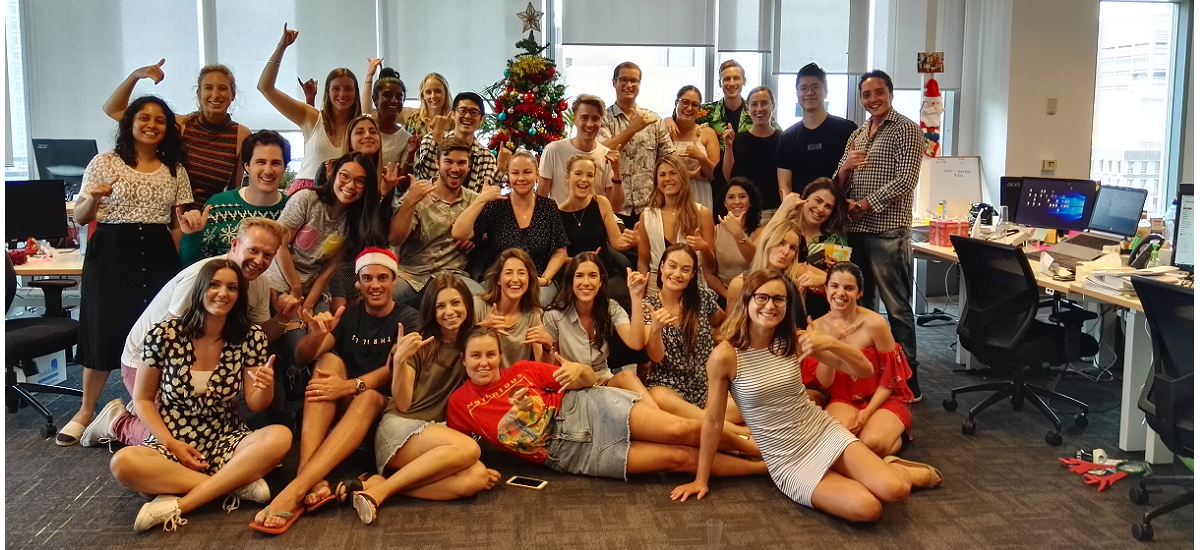
Is building a strong talent brand a “must have” or “nice to have” for modern employers?
Definitely a “must have”. Especially for Gen Y, they want to be coming to a place where they don’t only do what they enjoy doing but also a place where they feel welcome and are surrounded by like-minded individuals. Showing them what our culture is about, what our workplace looks like (maybe even giving them a sneak peek into our office playlists), how we celebrate success and what we do together outside of our workplace, is a no-brainer. This way they will already anticipate if this is an environment they would love to be part of or not.
What has been the process of building a strong talent brand at Meltwater?
We don’t have a designated team or employees for building our talent brand. I believe this should be a common effort of recruitment, marketing and HR, but, ultimately, all employees are responsible for this. Of course, all of us have a slightly different goal but at the end of the day, we all want to increase our brand awareness. I drive different initiatives, such as encouraging our employees to write blog posts, partner with top universities and students’ societies and provide training to all newbies (regardless of what team they join) on how to manage/promote our brand on LinkedIn. I already started this in my last job and it worked really well so took it over with me to Meltwater. It only takes about 15 minutes (if they’re in Sydney, its F2F, if in any other office, it’s via a video Skype call) but you would be surprised how little people know about different functions on LinkedIn and how to use them to your advantage. I always start the training with showing them some numbers on how many people interact with our brand on daily basis which always leads them to understand why this training is so important.
What is your social media strategy when it comes to employer branding?
I’m a huge advocate of LinkedIn and that’s where I spend lots of my time during the day. From my experience, the most quality talent is right there and it’s easy to tap into. On the other hand, it is true that the Gen Y don’t necessarily have a LinkedIn profile (yet!) and so it is important to build a strong strategy on their favourite social channels, such as Instagram and Snapchat – this is work in progress for us right now!

How do you use content marketing and storytelling methods on LinkedIn to generate stronger candidate pipelines?
As mentioned before, I love LinkedIn and consider content marketing as a great tool for raising brand awareness. I always make sure my posts have a purpose and most importantly, have a personal touch. Sharing only jobs, I’m currently hiring for wouldn’t make the cut! I divide my posts in 25% about our office life/culture, 25% about company updates, 25% about job posts (always accompanied by the right culture pic!) and 25% about my personal/professional interests. Sometimes it’s hard to keep the office life pictures to only 25% because there’s always something happening (ranging from a simple celebration of someone’s birthday – yes, everyone loves a good piece of cake! – through celebrating a new deal that just came in, to those crazy closing days when we always have a theme and dress up).
How does Meltwater empower their employees to tell their company story?
With the high retention we have, I feel like we don’t even need to empower our employees to tell the story (esp. off line)! We’ve had great examples when my colleagues randomly met people in a shop, bar or a taxi, started a conversation and suddenly, I had a referral, or we had a new client! It’s great when you are surrounded by people who are passionate about the company they work for!
What is the role of the leadership team in creating a powerful talent brand of Meltwater?
Our leadership team is active mainly on LinkedIn, giving advice and tips on how to better understand the billions of conversations happening online and how PR and Marketing Managers can use the #OutsideInsight (as we call it) to make their life easier. Meltwater started investing in AI already in 2013 and has heavily increased that in the past 18 months when we acquired 7 start ups (mainly based around AI). #OutsideInsight (which is a part of our software) leverages AI to discover valuable insights from external data, helping business executives make better, more forward-looking decisions.
We recently introduced a developed “Give back” program that enables our employees to take work days off to contribute to causes they care deeply about. My colleague Laura Rowland (Director of Support APAC, now based in our Melbourne office but soon to relocate to our Shanghai office) was the first one to take a full advantage of this new initiative and spent 2 days with the Mirabel Foundation which is the only organisation in Australia specifically addressing the needs of children who have been orphaned or abandoned due to parental drug use.
What are your company values and how (when and where?) do you communicate them?
Our values are at the core of our culture and can be summed up by the acronym MER, which means “more” in Norwegian (our founder Jorn Lyseggen comes from Norway). The values are:
Moro = fun. We believe that to become successful as a whole, we should all enjoy ourselves. That’s why we promote a fun, collaborative working environment.
Enere = number 1. At Meltwater, average isn’t good enough. Our goal is to build a groundbreaking company supported by a thriving culture in which our people aspire to exceed their personal expectations.
Respekt = respect. We believe it matters how a company or an individual becomes number one. Striving to be the best doesn’t mean sharp elbows: we should all treat our colleagues and customers with respect and humility.
These values have been with us from Day 1 in 2001 and are really a true heart of the way how we operate. We begin educating future employees about our values during our interview process and we communicate them very frequently; they guide us through everything we do, from how we prioritize our objectives and make decisions to how we clarify expectations and measure our success.

Can you give us some examples of your innovative HR / talent management policies? How do you communicate them internally and externally?
There are a couple of things we do differently. We only promote from within and based on merits, not tenure. All managerial roles are filled internally which gives lots of opportunities for our own employees. Candidates typically realize this when they come here and are interviewed by other people who are also Gen Y. It proves these people have been promoted quickly, based on their experience here.
We foster an environment which promotes socializing. We have monthly social events (including a dress code which is usually topical depending on what’s happening around us, such as tennis dress code for the Australian Open, Chinese dress code for Chinese New Year but we also had random ones such as rock star dress code or Italian one!) and every two years we all go to what we call a “Kick Off” – three – four days company conference which is always held at a different location and everyone who’s been with us for over a year gets to go. I was lucky enough that when I joined last year in January, there was a Kick Off happening in March and I also went to Thailand! It was fantastic to meet Jorn, our founder, my colleagues from all over the world and understand where we are going as a company (I do believe this was crucial for the success in my role as it gave me even more insightful exposure to our values and what they actually mean). I cannot wait for the next one!
How you measure your success? What is (or should be) the most important metric for a great recruiter/ employer branding expert?
It may sound like a cliché, but I’m driven by the success of my hires. When I see people, who joined us only few months ago closing big deals and really enjoying their work and our culture, that’s what makes me get out of bed every morning and keep doing what I’m doing.
I don’t think you can’t pick up the most important metric for a great recruiter, especially when talking about in-house recruitment. It should be a combination of a number of things, such as the amount and quality of hires, providing positive and effective recruitment experience (regardless of the outcome) and increasing the brand awareness.
Thank you for the interview!
Thank you!
***
Picture Credit: Leni Rokosova, Meltwater
]]>
While it all sounds perfect (and some days, I think it is quite close to it), I think sometimes this is life, right? You are finally settled, comfortable, and in your routine, only then faced with a decision to change it all up again. Maybe you are wondering why he cannot just come to Prague – well, the main reasons are that he would have trouble finding a good paying and growth opportunity job in comparison to London (the reality – he is an accountant). And while I love my colleagues and enjoy the work most of the time, I also know that I cannot stay in this position forever and there will come a time in which I need to move on. So hence, that time is now.

Something amazing and unexpected happened when I told my boss I was leaving. I was offered by my company to work from London. I was blown away. I didn’t think it was an option because it seemed a bit unrealistic due to the salary level differences between the two countries. However, it became a reality. It is such a helpful transition for me and entering into marriage this year – I was speechless.
I believe these things tend to happen when:
- You are doing the job the best you can. Sure, you have days where you are not so focused or motivated or you are constantly thinking if this is the right direction, but you do what you can. You show up and you do what you say you are going to do. Imperfect progress. And of course, look for something else if you know it is not the right fit at all.
- Kindness and humility. I am convinced these two qualities overrule anything else and always lead to more.
- Trust and faith – I am in a phase when I am trying to not predict my life anymore or control it so much that I do not allow other amazing things to happen. To keep going and trusting that Someone is looking out for me – not in a genie sort of way, but in a very real way even if not always in my timing that I wish for.
I find myself always searching for the next thing. I am a changer. But at the same time, there is such beauty in being open to what crosses your path. My heart of hearts desire to help women and girls trapped in human trafficking – how and doing what exactly? I am not quite sure. Sometimes I want to quit my job and work for a nonprofit doing just that, but then maybe in the end, I will be more effective in this role later especially in the financial realm. I have never worked in a charity so I think my expectations are high that if I quit to do that, I hope to change the world. But I believe we can change the world in ANY role and in ANY position – especially when we let go a bit of our own controlled timeline and path.
My next adventure just started in December in London. I honestly do not know what the future holds in regards to a career, but at least for the six months I do which is all I need for now.
The modern career woman: BOLD. GRACIOUS. KIND. HUMBLE. DETERMINED. OPEN. ADVENTUREOUS. LOVING. THANKFUL. And even sometimes not so stubborn (although most of the time, she probably is) and willing to give up some of her freedom and independence for something greater – that, in the end, offers more freedom than she could ever imagine.
Cheers to London and becoming a team with a man I can call a true friend and the type of love I have waited for – I will keep you posted.
Heather Schnacke
]]>Olivia is recognized for her knowledge of marketing and branding in China; she was featured in Forbes and grew a WeChat account from 2,000 to 5,500 followers in just 6 months.
Today she shares with Coachify her top seven tips on using WeChat as a branding tool.
1. WeChat is a chatting app: engage, tell a story.
Branding in China is becoming more popular. In China or in Hong Kong when you are outside there are bright neons and signs everywhere. However, people are not paying attention to that, they don’t read advertisements on the windows anymore – everyone is looking at their phone. Especially young, Chinese consumers nowadays want to disconnect from all the noise of advertisement.
We are getting so focused on telling our own stories and getting involved in other people stories – just look at your WeChat moments. Why would brands be not doing it? Why would brand not tell their stories to better connect with people? The key question is: how can brands better connect with their customers?
Storytelling and personalization are the answers. WeChat is a chatting app, people are expecting it to be interactive, and personalized, that’s what they crave from this platform. They expect to receive content that they can relate to and connect with on a personal level. Elijah Whaley, CMO at PARKLU makes a great point in this article about the digital consumer in China – your WeChat, and other mobile channels for that matter, should be fun, engaging and useful.
2. Make it about people.
Data from Tencent shows that people prefer to see and share content about their lives and those close to them. Reach out to your community, your coworkers, your customers and get them involved.
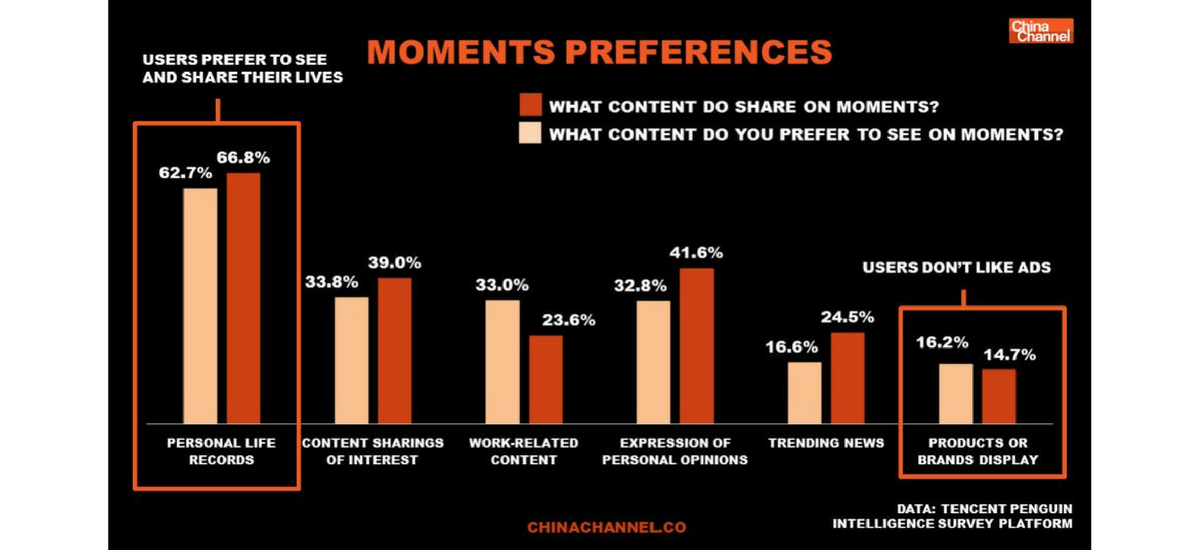
One of the most popular articles posted from the FitFam account was an article announcing an event in partnership with a women’s active wear brand. The article highlighted many of the reasons why people find the community so special, and what the core values mean to many of the young women in the community. It reached people on a personal, and emotional level, and ended with a call to action. It also included user-generated content in the form of photos that were taken of actual members of the community.
Other well-performing content comes from the FitFam partnership with Creative Humans writer Eduoard Bellin who interviews members of the FitFam community in-depth. These stories provide a window into the life of a friend, a workout partner – someone that people feel connected to and have an interest in learning about because he/she is part of their daily life.

3. KOLs are a must.
This is especially true for B2C brands. KOLs or influencers are a key strategy for many brands. They’ve amassed their followers through blogging, thought-leadership, as well as leveraging their celebrity status. KOLs are usually well-trusted and have a much more personal relationship with their fans. As this Boston Consulting Group article states; In China, shopping is about more than just the transaction. It’s about entertainment, discovery, and social engagement with friends, celebrities, and internet influencers.
Chinese consumers trust influencers, and are not as put-off by sponsored content as much as their Western counterparts. In fact, many KOLs have done such a good job building up their fan base and making a niche for themselves that many have their own online stores on Taobao and Tmall where they are making millions selling products.
Make sure you set the right expectations in terms of your budget and do your research carefully before selecting a KOL to work with your brand.
4. Look at the bigger picture.
I see many international brands coming into China and they have no idea what WeChat is, but they want it. The fact is that marketers need to take a step back and look at the bigger picture. What’s your WeChat strategy? What do you want to achieve on WeChat?
WeChat is not going to be your magic solution. It is not going to solve your brand awareness problem, it is not going to make your brand instantly ‘localized’ – this is what your messaging and brand positioning is for. Once you have a WeChat account, you can’t just start posting the same content as you are on Facebook and Instagram (more on this later) and expect to achieve results, even if you brand is well-known.
How you will measure success apart of number of followers? With follower acquisition growing increasingly competitive, look at other metrics such as number of views and shares. If you have 10,000 followers but no one is sharing your content, you do not have an effective WeChat account.
5. Give people a reason to follow you.
There are well over 10 million official accounts, QR codes are everywhere, but people are not just going to scan and follow your account willy-nilly. What is your account going to do for them? Just pushing out content for the sake of raising brand awareness is not enough. How can your account serve a purpose? Can you provide some sort of weekly or monthly roundup, or showcase special deals only available on certain days, is there a menu item that can serve a purpose such as a weekly event schedule or interactive H5 animation describing your business?
6. WeChat is not Facebook or Instagram.
For one, WeChat is much more closed off. Official Accounts do not enjoy the same visibility as brands on Facebook and Instagram have. If you want your content and your account to be seen by people who are not yet following you, your content must be shared by a follower on his/her Moments feed or sent in a message to personal contacts.
There are also more limitations for interacting with your followers, however some third-party CRM platforms can provide help with this. These limitations make it even more important to create quality content.
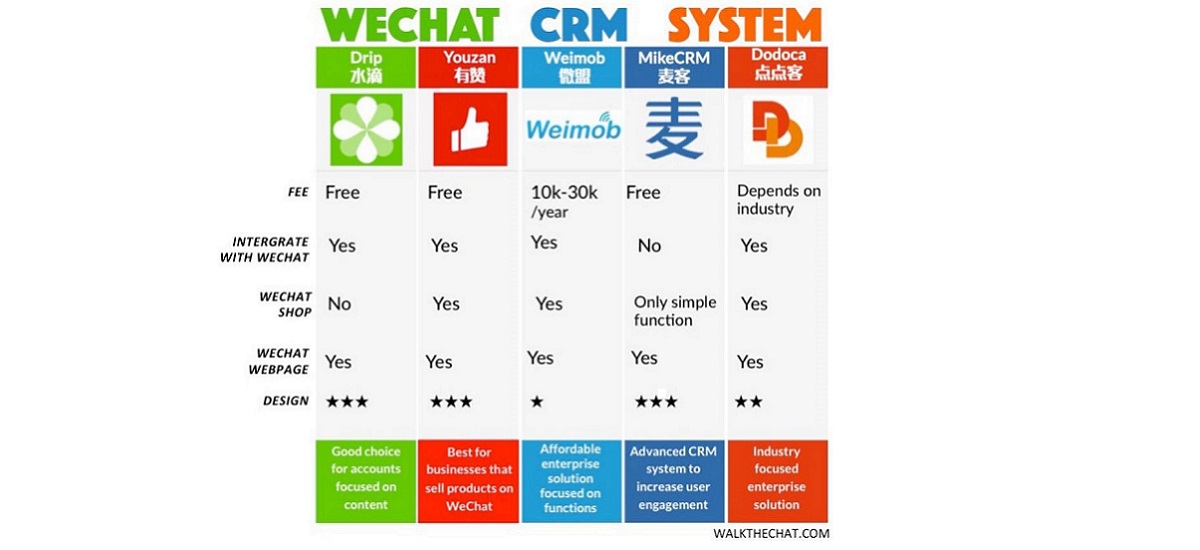
7. Plan your resources accordingly.
Who will manage your WeChat account? How you will connect it with your other social media channels and your website? Who can help you? Do you know what the workload looks like to put an effective, visually appealing article on WeChat?
Who will develop your content? Will you be doing your copywriting in house or will it be outsourced? Will you need translation? What about graphics and styling? All of these questions will help you determine how much you should be budgeting for your WeChat in terms of time and money. Don’t even apply for your WeChat account before you can answer these questions.
Picture Credit: Olivia Plotnick , ChinaChannel, FitFam, WalktheChat
]]>Read on to learn how the recruiters, HR and employer branding specialists from the different parts of the world generate stronger candidates’ pipelines by using content marketing and storytelling.
1.Introduce Social Media / LinkedIn Training
Did you know that employees have 10 times more connections on average than a company has followers? To leverage your employees personal brand and network introduce Social Media / LinkedIn training.
For example, Dell’s HR strategy including social media training resulted in higher quality hires, lower turnover and better engagement rates for Dell.
 “We have trained to date over 16,000 employees! We also train our summer interns as part of their development and introduction to Dell. The biggest success is the ongoing focus on the program including monthly power hours by topic (how to deal with trolls, what is the deal with SnapChat, etc.) as well as the revisiting and updating of the content. The opportunity we have is to continue to have executives model this activity and behaviour.” – says Jennifer Jones Newbill, Senior Manager, Global Candidate Attraction, Engagement and Experience at Dell.
“We have trained to date over 16,000 employees! We also train our summer interns as part of their development and introduction to Dell. The biggest success is the ongoing focus on the program including monthly power hours by topic (how to deal with trolls, what is the deal with SnapChat, etc.) as well as the revisiting and updating of the content. The opportunity we have is to continue to have executives model this activity and behaviour.” – says Jennifer Jones Newbill, Senior Manager, Global Candidate Attraction, Engagement and Experience at Dell.
Click HERE to read our case study About social media and recruiting with Jennifer Jones Newbill from Dell.
2. Empower your employees to tell the story about the company
Of course, they need to love their work in a first place, and the post should come from them, you cannot simply order a praising article. Readers will only spend their precious time on reading and sharing authentic stories. Pay attention to employees who already blog or vlog. Often those who relocate will be interested in documenting they journey.

3. Enchant your staff
Delight the staff with a small gesture or help when it is not expected, for example offering them flexible work arrangements or even showing that you listen, and you care:
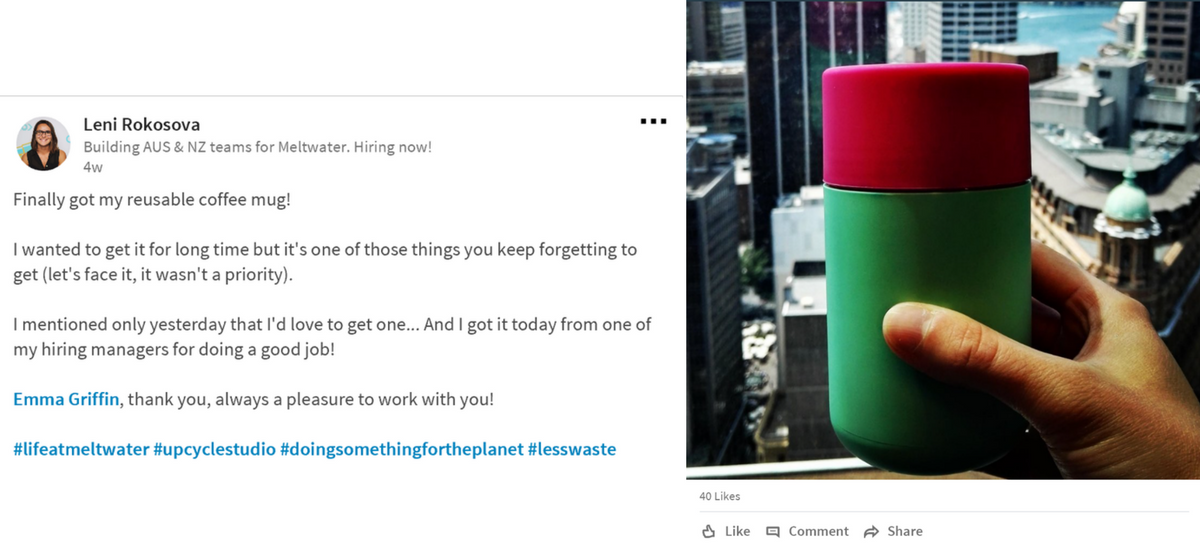 “When you enchant people, your goal is not make money from them or get them to do what you want, but to fill them with delight.”
“When you enchant people, your goal is not make money from them or get them to do what you want, but to fill them with delight.”
“(…) in a world of mass media, social media, and advertising media, it takes more than instant shallow, and temporary relationships to get the job done.”
Guy Kawasaki, Enchantment
4. Communicate your innovative HR policies
Challenge yourself (and your top management) to introduce a HR policy that could be shared as an interesting story.
Impossible? Here is the update from BrewDog:
“Thrilled to find out today that BrewDog have been shortlisted as a finalist in the 2018 Scottish Top Employers for Working Families Awards, in the ‘Best for Innovation’ category, for our Pawternity Leave initiative! (…)”
Seems standard but wait, did they misspell “paternity”? Or…
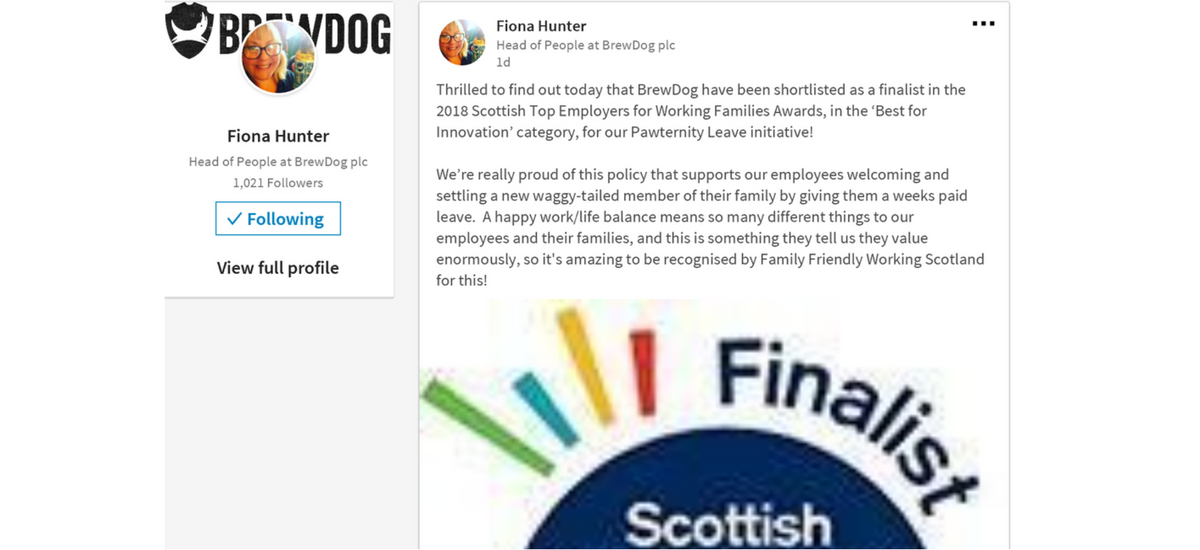
5. Measure success on your LinkedIn company page
Even if your company already has its LinkedIn page, you might strongly consider setting up a new page for your geographical region.
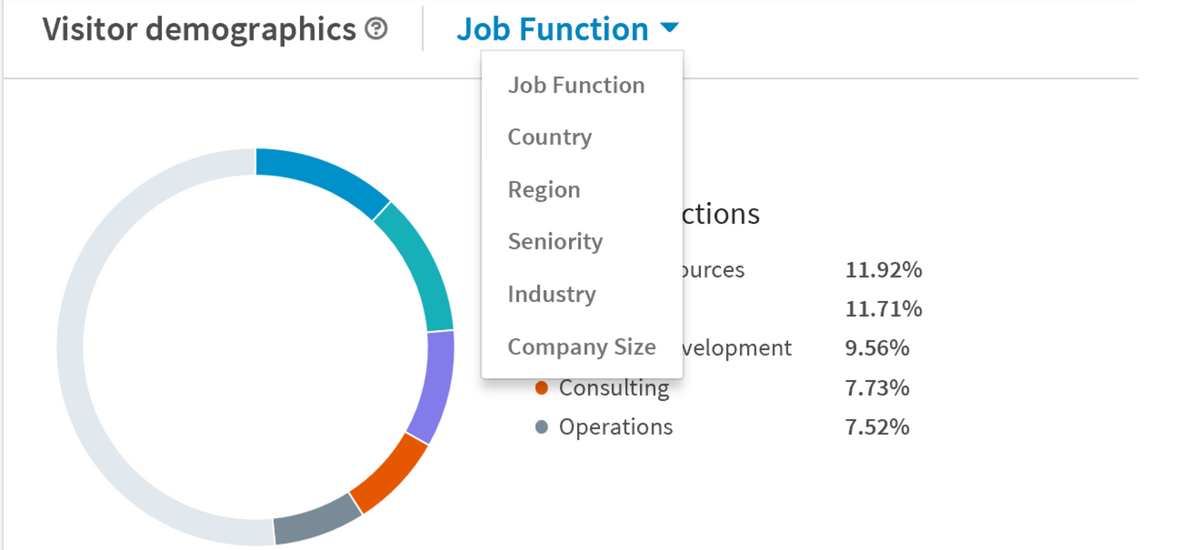
A simple company page is free yet give you some visitor demographics and some invaluable metric tools such as updates engagement and followers acquired in a specific month, week or even day.
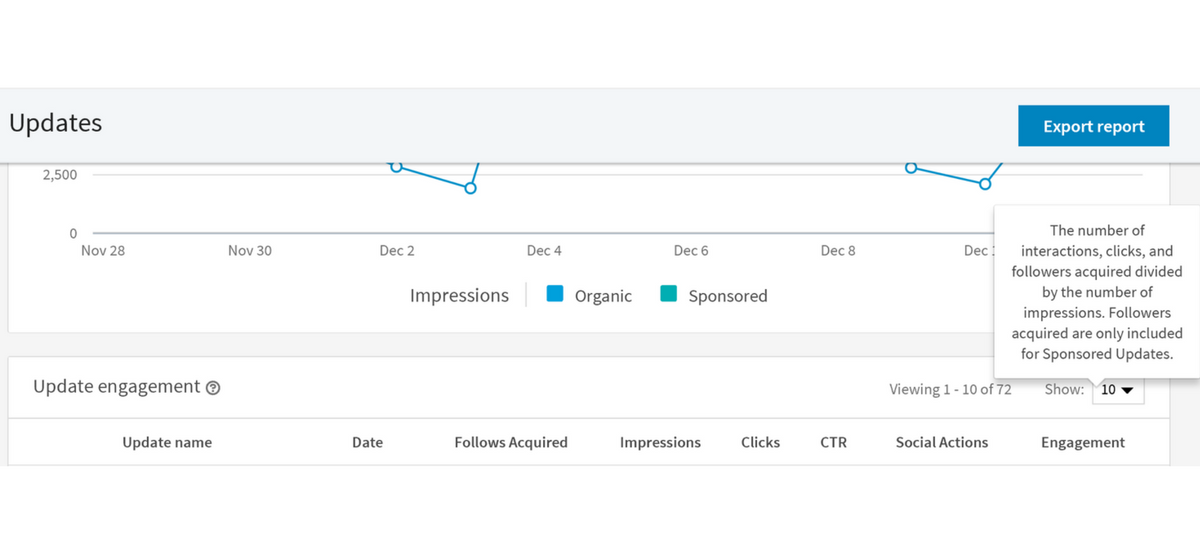 Followers acquired are only included for sponsored updates. You could still measure the success of your organic (not paid) updates, by looking at the followers acquired on a given day if you post no more than one update per day.
Followers acquired are only included for sponsored updates. You could still measure the success of your organic (not paid) updates, by looking at the followers acquired on a given day if you post no more than one update per day.
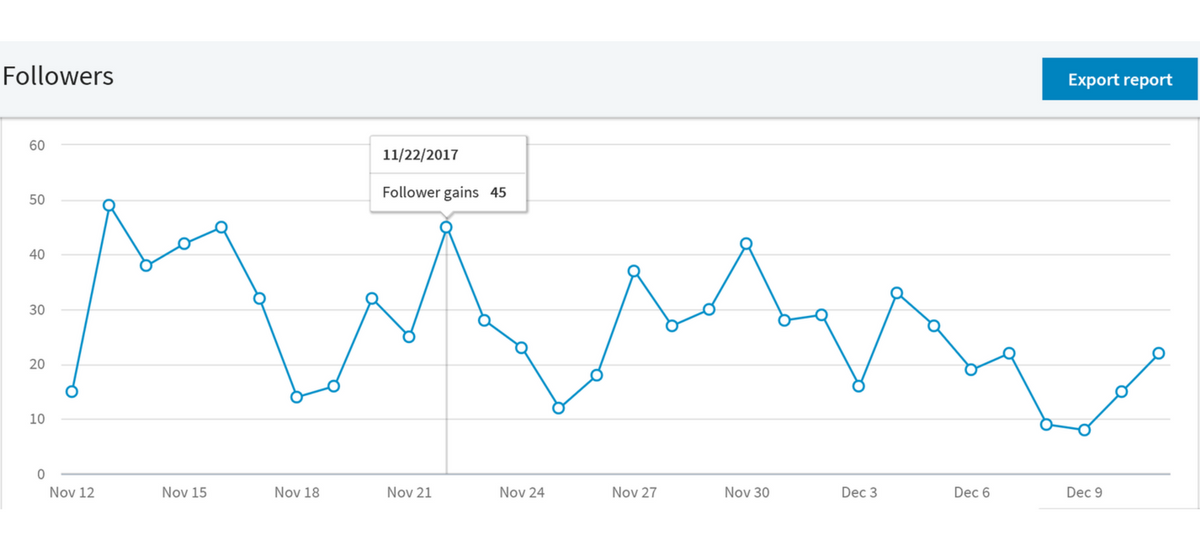
This article was inspired by the companies and experts from Scotland, Germany, Czech Republic, Australia, and China.
What are your favorite company updates or ideas for using LinkedIn as employer branding tool? Reach out on LinkedIn or Facebook; we would love to hear about the examples from other countries.
Beata Dziedzic
]]>Olivia, what is the story behind your move to China?
I started studying Chinese at St. Mary’s High School. It was the first high school in Oregon to offer Chinese program. The summer after my first year of studying we had an opportunity to come China and I was one of the seven students selected. We travelled all around China during the holiday, it was my first trip outside of the States. It was the Summer 2007, and we went to Beijing, Henan, and the southern part of China, Kunming in the Yunnan province. It was so different from anything I had known or been exposed to before. After that experience, I started thinking that this is the path that I wanted to follow. I studied Chinese and business throughout college and I completed my final six months of college in Beijing, at Beijing Language and Culture University. I moved there by myself and enrolled in an intensive language program. The classes were only taught in Chinese and I was the only American in my class, with no other native English speakers. I think I cried a lot (laugh) and I was a little bit miserable for about five months, but by the sixth month I was loving it: I have this distinctive memory of riding in a cab and passing all these incredible buildings in Beijing. The energy from the city was electrifying. I went back to Oregon, graduated and found a job at an international adoption agency. I was helping prospective parents through the first 1 to 2 years of the adoption process. I was also helping to update the organization’s website to drive more traffic and liaising with our Beijing office. While this role was a huge learning opportunity for me, I knew it wasn’t my career path. I really wanted to move back to China and pursue a career in international business.
How did you do it?
The easiest way to be back in China quickly was through a teaching job. To the surprise of my friends and family it only took me couple of weeks to get one. The whole process of getting a visa took around four months. My parents knew I wanted to move back to China. Although it was probably hard for them, they never questioned it. They knew I could do it and I knew I was determined to make it work. I ended up in a city nearby Shanghai. The first time I visited Shanghai in March 2015 I totally fell in love with the city. I said to myself: I must move here. And to think, I didn’t even know what I know now about the city!
How did you find your current job?
I was using LinkedIn, Smart Shanghai, E-China cities. I had quite a few interviews, but nothing really seemed to be the right role for me. I knew I was passionate about and storytelling and how brands design and market products. At that time, I didn’t know marketing and branding were the answer until after I had an interview for a marketing position with a solar energy company. Although it wasn’t the right fit I enjoyed working on several interview projects. It helped me to narrow down my search.
The position I am in now was posted on LinkedIn and I applied for it. I had fifty connections and an outdated profile picture, but I got called in for the interview. Now I have over 1,100 followers and have published several popular posts and articles, several of them receiving over 12,000 views. I was featured in Forbes because of a connection I made on LinkedIn. We began a conversation about getting qualified leads through HubSpot, and we ended up writing an article that was published on Forbes, in just over a week it surpassed 5,000 views.
I know people in my industry are using LinkedIn, but I don’t see people, especially my peers, using it to its full potential. Nowadays building your personal brand is extremely important, it is the biggest thing you will carry with you from job to job. The reality is that my generation will be changing jobs at least a few times throughout their careers. LinkedIn is the platform to build your professional presence online. Twitter and Instagram are important too, but the LinkedIn is the ultimate professional space where people are going to go to search not only for talent, but for thought leadership. How have you contributed, what do you have to say about your industry? Building and interacting with your network is important, and now is the time to utilize LinkedIn to do this . I wrote about in What I learned from LinkedIn’s first Official Meetup in China article.
Can you tell us about your typical day at work?
I work for Brandigo , a global branding and marketing agency, with offices in Shanghai, Boston and Manchester. I’m based in Shanghai as our in-house marketing manager. I develop and carry out our inbound marketing strategy, this means I’m working with our marketing automation software, HubSpot, which helps to attract and track qualified leads. Each day I’m checking how are people interacting with our website, looking at which content is the most read and shared, what problems are people searching for that we can help solve, and what channels are they using? I develop our content strategy, keep our marketing collaterals updated and looking fresh.
What are the skills needed to succeed in marketing and branding in China?
You have to realize that the market here is unlike anything you have seen and experienced before. I cannot tell you how many conversations I have with professionals in this industry who will tell you that no matter what, you must be prepared to throw most of what you know out the window. China is changing incredibly fast, much faster than in the West. I see many international brands coming into China and they have no idea what WeChat is, but they want it. The fact is that marketers need to take a step back and look at the bigger picture. China is massive, each city is like an individual country, and all these cities are very different from each other. A great WeChat will only get you so far, it’s about finding the right way to localize everything. If you can roll with the punches, see 10 steps ahead, listen to what is happening, and be flexible, you can survive in China.

What is your advice for someone who’s just relocating to China?
At the beginning, it seems like a massive life change. And it will be! But you have to be proactive and seek out groups and events that interest you. The unique aspect of being an expat is that you will almost always be able to relate to other expats on some level. You will share this common affinity for adventure and independence. There will be hard days, days when everything seem to be working against you and nothing makes sense. These tough days are amplified by the fact that you are other side of the world from everything you have ever known to be comforting. However, compared to other parts of China, living in Shanghai is easy, because most people speak English, and it is a modern, multi-cultural city. Find your community, find people who share the same values, interests, passions and surround yourself with people and projects which can expand your horizons and keep you grounded.
How did you find your community?
I moved here in August 2016 and didn’t know anyone in the city. I searched on Meetup.com and found Girl Gone International. This was the first community I got involved in and it gave me a gateway to many other friendships and relevant communities. The incredible thing about China is that we have WeChat, and WeChat groups. These groups can have up to 500 people in them, and when they are well managed, like the GGI (Girl Gone International) ones, they can be incredibly useful. After GGI I attended a number of networking events, and have since become actively involved in other groups such as IPWS (International Professional Women’s Society), TedxPuxi, and FitFam. The community that I have grown the most with has been FItFam. I got involved with FitFam – a free fitness community in Shanghai, which started about two years ago. Currently FitFam has 14 locations all over Shanghai with over 2,000 active members, and over 5,500 WeChat followers. I manage the FitFam WeChat account and communication strategies. The FitFam community is so special to me, everyone, foreigners and Chinese, are so supportive and always welcoming. This community has given me so much, especially because I have been able to combine my passion for fitness and healthy living with my passion for marketing and content creation. I truly believe that if I was back home I would not have pushed myself to get involved in so many different organizations, meet so many diverse people or challenged myself explore my passions. In Shanghai, you can meet so many incredible people from backgrounds you never imagined, try new things you didn’t even know existed, and simply get out of your comfort zone. I believe Shanghai gives you the opportunity to become a much stronger, empowered person.
What is the question no one asked you about, and you feel they should?
“What can you do differently?” I made a huge, and hard decision to leave my family and my home to come to another country to work. There are some tough days; it can be lonely, and sometimes nothing makes sense, but the hard work and sacrifice should be for something much bigger. My initial decision 10 years ago to start learning Chinese was because I wanted to do something out of the ordinary. During this past year I have tried to take in every experience, every opportunity that I possibly could. The more people I meet, the more I learn, not only about myself but also about the industry I work in. Today the world we live in is increasingly competitive, and I believe that to make an impact, not only in my own life, but also to impact the lives of others in a positive way, it requires us to seek out opportunities and challenges that that are outside of the norm. This is what I am looking to do.
Thank you, Olivia, we are looking forward our next interview: Everything About Branding.
Picture credit: Olivia Plotnick, Brandigo, VPHOTOS.
]]>A journey of a thousand miles begins with a single step.
Lao-tzu, Chinese Philosopher (604 BC – 531 BC)
In 2011 I quit my job in SAP recruitment in London and moved to China. Little did I know what was going to happen, but I hoped that the relocation would help me change my career.
I didn’t love my job, but I didn’t strongly dislike it either. As everywhere, it had its rainy Monday mornings when commuters were rushing through the Liverpool Station. Everyone seemed stressed out and unhappy about starting a new week in the City. However, as soon as I would get inside the office and make my coffee while chatting with colleagues, it didn’t seem that bad. ‘I can do it, I can get through another week, if I only survived Monday’ I would say to myself. There was also the thrill of headhunting, the constant buzz in the office, and a lot of laughs. Life was good and the closer to the weekend the better it was becoming. Around Wednesday, emails from my friends were starting to circulate as we were preparing for another fabulous weekend in London. It rarely happens that we are entirely happy or unhappy in our job, and I guess that makes any decision harder. When is the cutting off moment when we say: “I’m done with it and ready for a new role”? Once we have reached that stage another obstacle appears – we don’t have clarity on what we WANT.
I realized that what bothered me the most about my job was the fact that I didn’t feel challenged anymore. I didn’t want to live only for the weekend. I thought about moving to internal HR, as that was one of the most common “career transitions” for agency recruiters. I was also asking myself when was the last time I was happy at my job? The answer was three years ago, working as an executive search consultant in the energy sector. With that in mind, I was considering going back to the executive search. Then my boyfriend got a job offer in Beijing. We discussed three options: a long-distance relationship, me staying in London and trying to job hunt in Beijing, or finally quitting my job and relocating together. From a recruiter perspective, I knew that being in the right location could make a huge difference. Firstly, my CV with London and the UK number on it could go into the “bin folder” in a matter of seconds. Secondly, meeting hiring managers face to face is a small difference that makes the all the difference.
While discussing relocation, we also decided to get married. Three weeks later, on a Monday morning, I was rushing through Liverpool Station to work. I was going straight from the airport and I asked my manager if we could have a meeting. He knew I just came back from Las Vegas, he wasn’t particularly surprised about the marriage decision. However, he didn’t expect the news that I was now moving to Beijing.
I was moving to a country that I haven’t visited before. I didn’t know anyone there and I didn’t speak the language. A country that scores at the top of the most difficult places to live and work in the world. The goal was to find a new career path and I was excited about it, especially about the fact that everything was going to be different.
What happened in China?
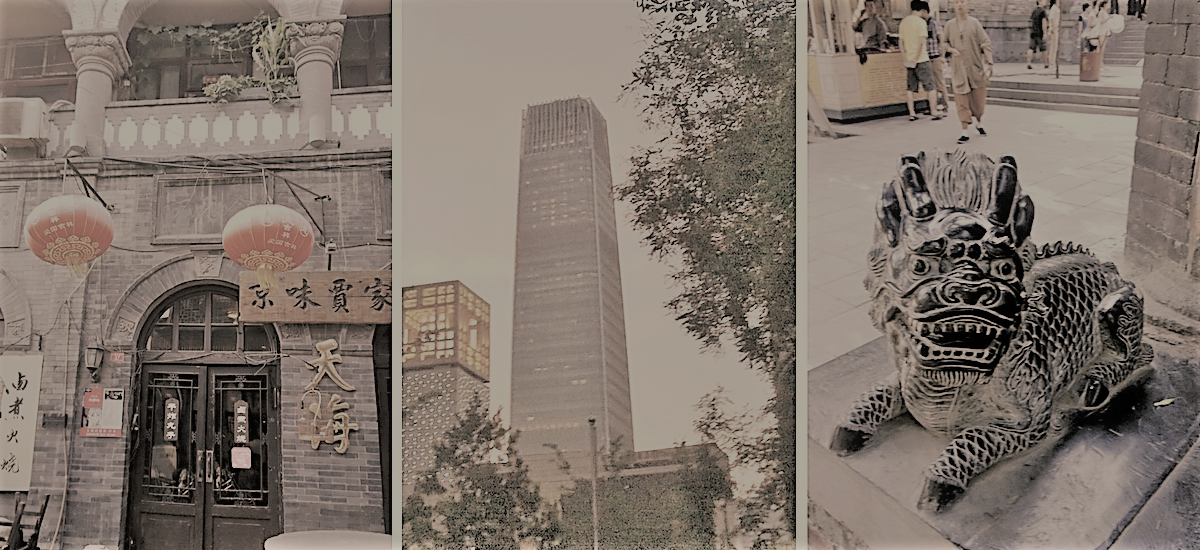
Since it wasn’t my first relocation experience, I was confident that soon I would find my dream job. However, my confidence was crushed and then rebuilt again. It turned out that majority of mid-level HR roles in China were reserved for Chinese speakers. One of the most shocking feedback replies was from P&G: We are only hiring native Chinese people for the HR department. Recruitment is a numbers game, so I set myself a target- twenty CVs to send out per week. I started to be headhunted by recruitment agencies and without any better option, I was going for every interview I was invited.
Over countless interviews and five formal job offers later (I rejected all of them), I was disillusioned with my job search. I accepted a role as the IT Recruitment Consultant. The same job I had in London. I realized that no matter how hard I tried I will never love this job. During that time, many foreigners asked me to consult them about the job market in Asia, their CVs, and interviewing. That was a first, small step to becoming a career coach in the future. I also enjoyed training my Chinese colleagues on recruitment best practices and social media.
One day I received a call about interviewing with another IT recruitment company. I explained that I was not looking for yet another similar role. “Why don’t you just meet the manager and see what happens?” said the recruiter. It was like hearing myself many times before, convincing my candidates to be open-minded and go for the interview.
During the interview, I was very clear about what I didn’t want and what interested me. The company decided to create a new, fixed term contract role for me, which was training and coaching their recruitment team. I was going to deliver what the company needed, doing the work I enjoyed. It turned out to be one of the best jobs I’ve ever had. Before my contract expired, I updated my LinkedIn profile, and I got headhunted for an intercultural trainer role. A new career in training and coaching had officially begun.
How can you approach your career transition abroad?
- Before you throw away your current career, think about the moments you enjoy at work. These are the good clues. I realized that I was keen on helping others to learn and grow or find a better job. I did like the recruitment ambiance, and the whole process of headhunting supported by social media. Now, I train others on social media recruiting. My recruitment experience comes in handy in my coaching work.
- Think about your niche skills and how you can solve the company’s problems. Find out what are their struggles and propose your solution. Pay attention to direct competitors of your current employer. These are usually the companies that will want you the most. In my case, I offered my knowledge of SAP market and hands-on expertise in recruitment to secure a training position.
- If you work for a larger company, a good place to start career transition could be your current workplace. Much of recruitment efforts is about mitigating the risk of hiring the wrong person. Once you are in company A, someone else has already taken the risk of recruiting you. It’s much easier to change roles or even a whole career internally.
- If you relocate with your family, ask your partner’s company for career assistance. More and more companies deliver career coaching for relocating partners. Others don’t have formal programs in place yet, but they can provide some extra budget for it. I predict that it will become a growing trend because many more relocating families want to continue dual careers.
- Do an inventory of yourself (HERE is the book that will teach that) but don’t keep it for yourself. Go out, meet people, interview, brainstorm. Have the courage to say: I like your company, but I don’t like the job. If the company truly wants you, they will create a job for you. YES! It does happen.
Beata Dziedzic
Pictures: BD, Heather Schnacke, Canva
]]>Erin Leigh studied public relations, advertising and applied communication at Western Michigan University. She came to China after graduating from college. She has been living in Shanghai for over five years, working in PR and marketing, before co-founding Spare Leash. Erin has Oliver (labrador mix), Betty (mini schnauzer), and Max (terrier mix). They used to be foster animals, but she ended up adopting them. Erin usually fosters one more dog every month. She also rescues kittens; she bottle-feeds them and looks after them while searching for adopters.
Spare Leash is dedicated to making life easier for pets and pet owners by providing loving and trustworthy pet sitters in Shanghai. Their services are safe, reliable and cage free. The company was founded in Shanghai, in 2016. In the same year, Spare Leash was awarded by Time Out Love Shanghai for Lifestyle Service of the Year.
How Spare Leash started?
Elsa: It began in 2016 when I wanted to adopt a dog from the street in Shanghai. I was still a student, and I was going traveling for a whole month. None of my friends could take care of him. Finally, I didn’t adopt this dog. However, I started to think how we can all help each other looking after pets when we travel. I had an idea, and I spent a few months thinking about Spare Leash and how I can make that happen. I had mutual friends with Erin. She was facilitating pets’ adoptions in Shanghai.
Erin: One day, Elsa texted me out of the blue, saying: “I need to talk to you. Meet me for lunch”. We met at one of my favorite restaurants, Kommune. Elsa told me about her idea. It was also a part of her university project.
Elsa: I had a class called Entrepreneurship, and that’s how I started to look at it from a business perspective. My initial idea was a pet hotel, but I wasn’t 100% happy with that and kept on brainstorming. I went to Australia for a month, and because I didn’t adopt the dog, I was thinking about it during the whole trip. I was doing my research, writing down my ideas and a business plan. When I came back, I met Erin.
Erin: Elsa nearly had a business plan and the avenue laid out, as well as the name and the logo. Right away I said: YES. The very next day we were in my living room, my three dogs were running around, and we were starting the business. It was around early April. I had just quit my job in PR.
Elsa: I was in the last semester of my Bachelor’s degree majoring in business. I had in my final exams. My final thesis was about the WeChat business, so I was going to many business events and learning from hands-on entrepreneurs.
Erin: We first built a website, which took a month. Then we had a launch party – a charity event co-organized with Best Friends China.
Elsa: We got our first client during this event. The first interviews with sitters happened in Erin’s apartment.
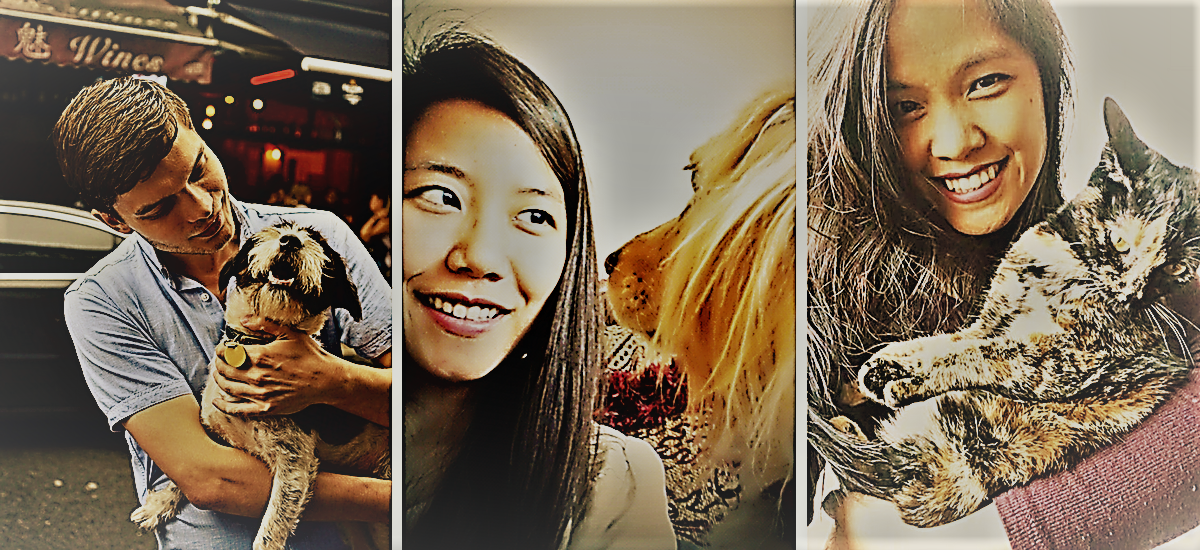 How do you recruit your sitters?
How do you recruit your sitters?
Erin: We don’t want people who do it only for money. The main driving factor should be their genuine passion for animals. You recognize straight away the right person: they have so many stories to tell about their cats and dogs. They say all the time: “my dog” or “my cat” and lay out all the pictures. We meet every candidate in person, and if they get a job, they go through the training.
Elsa: Some expats are in Shanghai for a short period, so they didn’t relocate with their pets. They work for us to be closer to animals and earn some extra money. These are usually good candidates. We put the job advert in Smart Shanghai and spread the word, searching for animal lovers. Everyone who wants to become our sitter needs to fill out the application first. We also ask for their photos with pets.
Erin: If someone cannot provide a picture it’s a huge warning flag.
Elsa: One candidate said that he had a lot of experience with cats and dogs, but he could only provide a picture with a cow. That was a no!
Tell us about everyday life at Spare Leash.
Elsa: We work like a dating app; getting pets’ owners agreements and pairing them up with the right sitter. We sometimes use the co-working office at WeWork, or we work at Baker and Spice café at Anfu Lu where we meet many people with their dogs. We chat with them and sometimes they even become our clients. We organize many events. For example, we had a charity Thanksgiving where people could drop the stuff like beddings or pet food that went to two shelters in Shanghai. One shelter is fully outside and they have over hundred dogs. It was perfect timing with the winter coming up and shelters in need of blankets. We also had a happy hour. It was a cold day, but many people came. Our next event will be a training for dog owners and sitters. We want our clients and sitters to interact. Now we have a team of hundred seventy sitters which is a tremendous growth. Last summer we only had sixty of them.
When you first started, you had fifteen sitters and three clients and grew to hundred seventy sitters and three hundred customers in less than a year. You were also awarded by Time Out Love Shanghai for Lifestyle Service of the Year. What is the secret of your success?
Elsa: Spare Leash sitters ensure individual care as well as daily pictures and updates.
Erin: Instead of putting their animal into a pet hotel, our clients prefer their pets looked after in the house, by someone who is a true animal lover. The main problem of expats pets’ owners in Shanghai is finding someone to care for their animals while they travel. It’s also a key barrier for expats who want to adopt an animal in Shanghai. We fixed it.
Elsa: Spare Leash enabled me to adopt my dog. Now I can travel knowing that someone reliable will look after my dog while I’m away. The “no cage” aspect is paramount to us. In Sweden, we don’t have pet shops and pet hotels with caged animals at all. Here in China, shops with caged animals are everywhere.
I looked at the prices in Shanghai, and in many cases, it’s less expensive to hire Spare Leash than to put the pet into a pet hotel. Also, you are a real lifesaver for cat owners who love to travel. For most cats, it’s much less stressful to be looked after at their house.
Erin: Our sitters also give their full attention to pets. It’s not unusual that they cry when the owner is back and they must part with an animal. Our sitter’s boyfriend just called me and said: “Anita cannot work for Spare Leash anymore.” I asked: “What did we do to her?” He said: “The owner picked the dog two days ago and Anita is still crying.” This is how our sitters get attached to the dogs. They treat these animals as if they were their own. We want clients to be worry- free because their dog will be preoccupied with a sitter instead of staring at the window, waiting for the owner to come back.
Elsa: I once boarded a dog who used to sleep in their owner’s bed. Therefore, at my house, he was also allowed to sleep on the pillow next to me. That’s what he does at home, so I didn’t say no. He loved it and got attached to me. The family was super happy, too. Photos are also very important to us. When I leave my dog with someone else, I want to receive at least three pictures a day, and our clients can expect the same.
Aside from Spare Leash, you both rescue animals as well.
Erin: It started a long time ago before college. I was rescuing, adopting and rehoming animals. Coming to Shanghai from Michigan I saw way more stray animals. I felt something had to be done about it, so I joined a couple of groups that rescued animals in Shanghai. With the power of WeChat, we rescue animals, make them safe, and find them a comfortable home.
Elsa: I adopted my dog, Betsy, from Rose. I was going to foster, but I ended up adopting her. Now I’m getting a new foster, Luna, this week.
Erin: It’s 24/7. You surround yourself with groups of people who post updates about animals in need on WeChat and whoever is close will go and rescue the animal. There is a bunch of groups: Best Friends China, JAR, People for Pets, and Rose’s Rescue. Right now, we are working closely with Rose’s Rescue. She dedicates herself to saving animals. We help donate and fundraise for the vet bills.
How do you fundraise to help animals in need?
Erin: We organize events. In March, we did a Pet Talk and Ride for Rescues event and raised over 2500RMB for Rose’s Rescue. We have another one coming up!
Elsa: The Shanghai pet community is always willing to help animals in need so our events are super fun and it’s a great way to give back.
Which social media do you use?
Erin: WeChat. It’s right there in front of you; you can request the phone number, the resume of potential adopter and ask basic questions. Our friend went to Hangzhou where he found a dog that was almost dying and asked us what to do. He ended up keeping the dog and recently sent us “before” and “after” pictures- he loves his dog. It’s just one of the many stories. We help to facilitate adoptions for dogs but also a lot of cats.
Erin: We also educate people: “If you find a stray animal that needs helps this is what to do. First, you take them to the vet. Taking a picture and walking away is not helpful.”
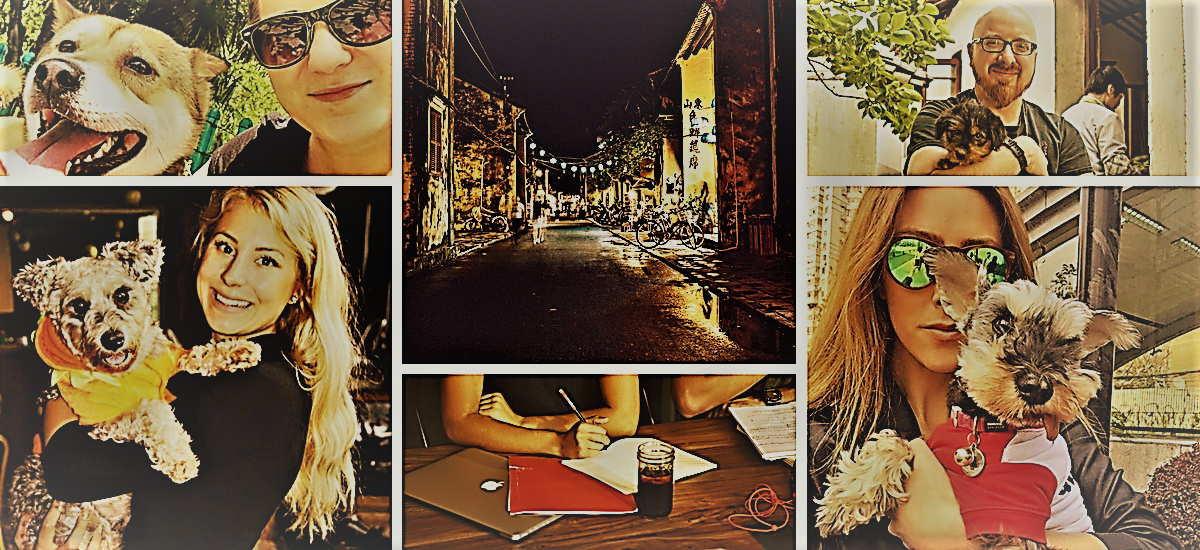 I’m so thrilled to hear all these stories. Let me ask you the last question, what’s your advice for other expats wanting to start a business?
I’m so thrilled to hear all these stories. Let me ask you the last question, what’s your advice for other expats wanting to start a business?
Elsa: It takes good planning. My tutor says “put the idea in the fridge”. Let it chill a little bit, think about it, open your fridge sometimes and look at it. In the meantime, surround yourself with the right people, go for meetings about start-ups. Find someone who has the skills that you don’t have.
Erin: Some people do that for three years while working full time. I can only say: DO IT. When Elsa came with her idea, I said: “when do we start?” Don’t just have the idea, create it.
Interested in learning more about Spare Leash? Contact them on www.spareleash.com
Pictures: Spare Leash and Canva
]]>
Tiziana Figliolia is the Sr. Vice President, Global Business Operations and Finance at PTC. She is also the President and Board Member of International Professional Women Association (IPWS) in Shanghai, and a speaker on the topic of gender diversity, equality and women empowerment (Women TEDx Shanghai Salon, Shanghai International Forum on Women’s Development).
Tiziana is a global leader with 20 years of experience working with technology companies publicly traded and startups, with a wide range of strategy, planning, finance, customer support, sales & operations, R&D, and business partnering related responsibilities. As a native Italian and after graduating in Economics, Tiziana realized that moving to the USA was the right choice to springboard her career. Being a naturally curious and open minded person, Tiziana relocated a few times with her family and progressed her career around the world. Currently, she lives with her husband and son in Shanghai, a city, which she finds the most international and cosmopolitan from all the international cities.
About IPWS:
International Professional Women’s Society is a non-profit organization that provides professional women with different platforms to connect and foster personal and professional growth. IPWS has a community reach of more than 2000 women.
***
Tiziana talks with Coachify about her motivations to volunteer, engage with a local community and empower professional women, as well as how it helped her to live a fulfilled life. One of the lessons we can learn from her is: choose a volunteering project or community that resonates with your life vision and passion.
Tiziana, how did you become interested in IPWS?
After working for some time in China, and completing my MBA, I felt there was a void in my life, which needed to be filled. I’ve accomplished a lot professionally, I have a great family, but I needed more to fulfill my purpose. More than the traditional work/life balance, I believe in living an integrated life where professional, personal (family) and social (giving back to the community) are interconnected and a measure of who we are, what we do and how we accomplish our life goals. These are three very fundamental parts of who I am. At the time I felt that the social aspect was incomplete. I asked myself: How do I give back? How do I make an impact on the community? I started to look around, and when my friend Margot invited me to an IPWS event, I joined. I enjoyed the crowd and the ambiance of the event and worked my way to join the Board of Directors and become the President of the organization, now for the past four years. IPWS was and still is an excellent fit in terms what I was trying to achieve.
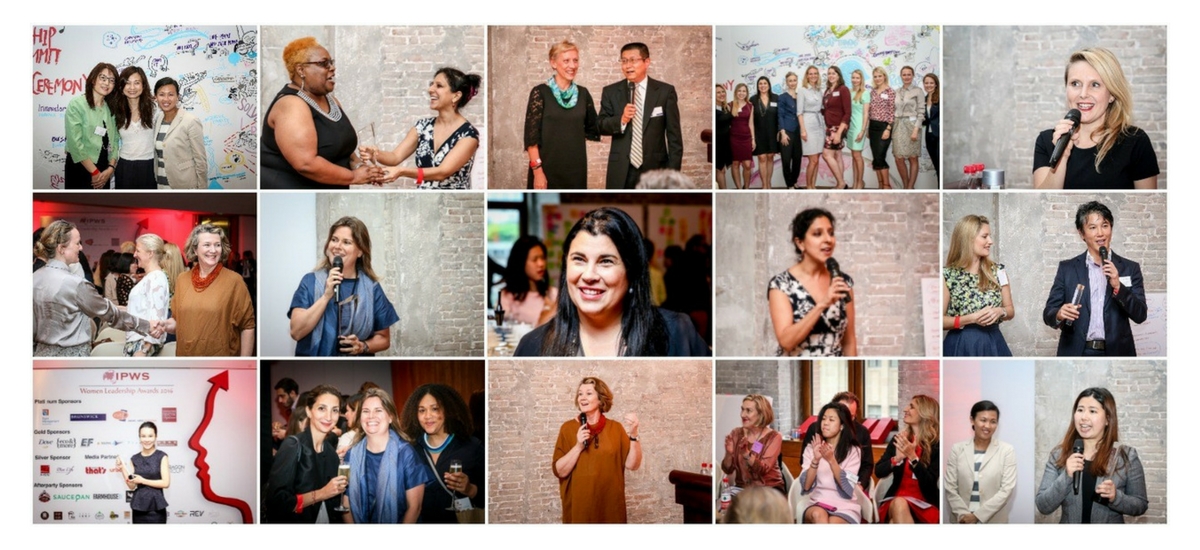 You are describing it in a very modest way.
You are describing it in a very modest way.
I’ve started to really match my personal vision with that one of the organization, which is to impact women individually and their personal and professional communities. That to me is very fulfilling, and I realize that in the process I gain more than I give.
How women come together in Shanghai?
In Shanghai, there are many organizations dedicated to women, at my last count there were 15 or more. In some ways, we overlap, and in another way, we fill the needs of the community organically. For example, the AmCham Women Executive Network, which I am part of is dedicated to executive women, while Lean In China and the Women in Leadership League are dedicated to university students and young professionals respectively. I like to think of IPWS as the most inclusive community as we reach women of all ages and professional background. Regardless of each organization’s nature, we found ways to collaborate, and that’s very powerful. We hold two roundtables a year to share our activities, and once or twice a year we organize a joint charitable event to benefit gender-focused non-profits. The most recent event was called Power Tribe where we fundraised for an organization to buy eyeglasses for women in rural China.
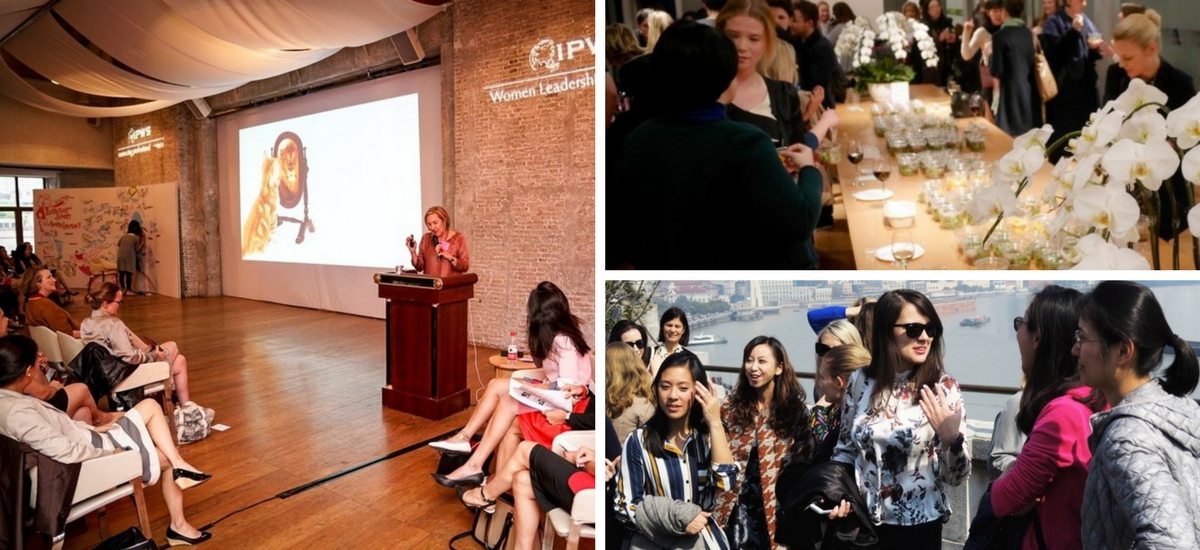
Does community work help in life abroad?
Yes. Shanghai is an easy city to live in, but at the same time, it can be very foreign. To have a network, support and reach can really help the quality of life and work we lead here. I am ready to bet that through my IPWS built network (and WeChat) I could be of help with anything you would ask me.
Our IPWS members are women who work in Shanghai or are in career transition because the family moved or because they are young professionals who moved here to start their career. IPWS activities and the community itself encourage these women’s feeling of empowerment, action-taking initiatives, and support for each other, so that they can get the most out of living here. But not just here, in fact, we often refer to IPWS as a global community. Shanghai is a very transient place, where people come and go. There are so many people I met through IPWS that now live all over the world. Switzerland, Germany, or North Carolina, you name it. Personally, I have a developed a global network of people with whom I share the experience and the values acquired from life abroad. It’s a very strong tie to be treasured.
Interested to learn more about IPWS? Join a career workshop How to optimize your job search in Shanghai HERE.
Photos: Tiziana Figliolia and IPWS
]]>I love being able to connect with talent digitally and in-person and especially leveraging social media to tell a story behind some of the jobs that I recruit for.
I’ve been recruiting for the last 5.5 years, working across various industries ranging from healthcare, IT, marketing, creative, retail in both agency and corporate settings. I’ve been fortunate to recruit for many top brands & companies including Microsoft, Starbucks, Amazon, and Expedia.
Social media allows recruiters to connect with prospects in a more meaningful, authentic, and engaging ways than the traditional “submit and pray” system. For me, this is the most exciting part of my job as a social recruiter. I especially love showing off “behind the scenes” content and information to talent – whether that be fun group photos of the team or writing and sharing a blog on the “human” aspect of each job, team or organization.
Your LinkedIn summary is very impressive. It has all the “right ingredients” of a powerful summary, which are: storytelling, description of what you and your company do, call to action, keywords, and imagery. How did you come up with it?
Thank you! You know, in any profession, whether you’re a sales person, marketer or an engineer – there are tons of other people who do the same job you do. If you look across my network, I’m sure you can find many recruiters who have worked for the same organization or have held similar roles and I have. Given that situation, you have to figure out a way to stand out from the herd in an authentic and memorable way.
When I wrote this particular summary of mine, I thought about few things: 1) Who am I and what is my “brand”? 2) What are things I’m particularly good at? 3) What type of stuff gets me really excited?
The first part is really important – knowing your personal brand. Beyond being a recruiter at “company A” or being a specific industry recruiter, I have my own “flavor” or brand that I represent regardless of the company I work for or team I’m on. You have to have clarity & consistency in that brand & messaging.
The second piece is also important because that’s what makes you unique and different – your superpower if you will. You definitely need to understand the value you bring to the table and be able to celebrate that differentiator.
Third is being able to articulate the area of passion. This is where I ideally like to build more of my career on, and I think it’s beneficial for others to know as well. I’d like to think this is the reason why you reached out to me for an interview. I think overall you open up more doors by being transparent and letting others know what drives you.

You have worked as a corporate and agency recruiter since 2011. How did recruitment transform over the years?
I was fortunate enough to be a recruiter after the days of newspaper job ads and faxing or physically mailing over resumes (although in my early agency days I did receive some faxed resumes, no joke!). The biggest difference between when I initially started recruiting in 2011 and now is the realization by the industry that recruitment is a form of marketing! With the rise of social media especially, candidates want that premier experience – not only do they want “a job” but they want to be connected to the brand and want to know more about the culture and lifestyle that surrounds it. Also, top talent has options – so much like winning over customers, we have to strategically advertise and market our jobs and opportunities in a way that is exciting and makes candidates say, “THAT’S the job I want to go for.” Social media gives candidates a voice and a way to reach out & interact with recruiters and hiring managers. As recruiters and hiring managers, we also have to be ready and equipped to tell that story in a consistent and meaningful way.
Microsoft’s Social Media Ambassador Community, which I’m a part of currently is exactly that – leveraging our best brand advocates (our own employees) to tell their unique stories. The community was created by our Global Talent Acquisition Excellence team for recruiters who are passionate about social recruiting and storytelling. We brainstorm and come up with different strategies on how we can best leverage the social platforms to amplify our unique experiences surrounding our jobs. I’ve personally contributed by authoring several “recruiter tips” articles on our Microsoft JobsBlog Platform for candidates looking to get some insights on our application & interview process. I’ve also identified key employees in the business I support that can tell an exciting story related to their career that makes the roles they do personal and “human”. The community is great at amplifying different Microsoft news, events, and stories that resonate with our talent population. It is the force driving social recruiting initiatives, training, and employment marketing campaigns for our Global Talent Acquisition and client groups.
Who are your roles models?
In sourcing, I very much look up to Johnny Campbell at Social Talent. I’ve taken his Boolean blackbelt course and that totally raised my recruiting bar. He and his team always have great information about the latest recruiting trends and new ways of uncovering talent!
I also very much respect and look up to Al Short – who was one of my first recruiting influences (he was the one who introduced me to the world of recruiting!) and still to this day is the best manager I’ve ever had the pleasure of working under. He really believed in my potential, knew how to tap into my strengths and helped me shape into the recruiter that I am today. I’ll forever be grateful for his mentorship and encouragement.
Can you recommend to our readers the best resources on social recruitment, personal and employer branding?
I would definitely read and follow articles written by Johnny Campbell and the team at Social Talent – they publish some good content on recruitment overall. ERE media is also a good site to follow. If you haven’t seen Top Recruiter videos by Jer Langhans & Chris LaVoie you’re missing out! SmashFly also puts out a lot of recruitment marketing content that I find interesting.

How do you give back to the community?
I have a passion for helping out women and early in career talent in the areas around career coaching and development. I have previously given resume coaching, interview tips, as well as LinkedIn Profile workshop to a women’s professional network called the LEVO group, and have also given talks for local college business fraternity and alumni panel. It’s interesting how going to school is supposed to ultimately prepare you for skills you need in your “dream job”, yet they provide very little practical information about how you go about getting that job!
What is your take on providing feedback to candidates?
A lot of times candidates do not get any feedback about why they are not getting selected for an interview for a role they had applied to, or why they didn’t get the position if they did go interview. There are several reasons why companies cannot and will not provide specific feedback, but I want to take the mystery out of that as much as possible and be able to provide the best candidate experience even if they didn’t get the job (which happens to be the majority of applicants for most open jobs!).
People shouldn’t be selected for a job because of how well they interview or the way they format their resumes – but we currently have no way of judging talent otherwise. So if that is the case, I want to make sure they can be as prepared as possible.
Is building a strong personal brand a “must have” or “nice to have” for modern recruiters?
It’s for sure a MUST HAVE! If you want to not only be relevant but be an effective recruiter, you have to differentiate yourself to not only your candidates but your current and potential future employers as well. You’re a business of one with a unique & clear value proposition! You must make that clear to both the company you work for and for the industry you serve.
Thank you for sharing your insights, Maasa.
Thank you!
***
You can contact Maasa on Twitter: @maasawalker or LinkedIn: https://www.linkedin.com/in/maasawalker
Pictures: Maasa Walker and Microsoft
Pictures of Seattle: Matt Mrozinski, Twitter: @mattmrozinski
]]>